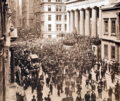Wikipedia:Today's featured article/requests/Panic of 1907
Panic of 1907
[edit]- This is the archived discussion of the TFAR nomination for the article below. Subsequent comments should be made on the appropriate discussion page (such as Wikipedia talk:Today's featured article/requests). Please do not modify this page unless you are renominating the article at TFAR. For renominations, please add
{{collapse top|Previous nomination}}to the top of the discussion and{{collapse bottom}}at the bottom, then complete a new nomination underneath. To do this, see the instructions at {{TFAR nom/doc}}.
The result was: not scheduled by Jimfbleak - talk to me? 13:28, 28 September 2017 (UTC)
The Panic of 1907 – also known as the 1907 Bankers' Panic or Knickerbocker Crisis – was a United States financial crisis that took place over a three-week period starting in mid-October, when the New York Stock Exchange fell almost 50% from its peak the previous year. Panic occurred, as this was during a time of economic recession, and there were numerous runs on banks and trust companies. The 1907 panic eventually spread throughout the nation when many state and local banks and businesses entered bankruptcy. Primary causes of the run included a retraction of market liquidity by a number of New York City banks and a loss of confidence among depositors, exacerbated by unregulated side bets at bucket shops. The panic was triggered by the failed attempt in October 1907 to corner the market on stock of the United Copper Company. When this bid failed, banks that had lent money to the cornering scheme suffered runs that later spread to affiliated banks and trusts, leading a week later to the downfall of the Knickerbocker Trust Company—New York City's third-largest trust. The collapse of the Knickerbocker spread fear throughout the city's trusts as regional banks withdrew reserves from New York City banks. Panic extended across the nation as vast numbers of people withdrew deposits from their regional banks. The panic might have deepened if not for the intervention of financier J. P. Morgan, who pledged large sums of his own money, and convinced other New York bankers to do the same, to shore up the banking system. The following year, Senator Nelson W. Aldrich established and chaired a commission to investigate the crisis and propose future solutions, leading to the creation of the Federal Reserve System. (Full article...)
- Most recent similar article(s): I don't recall anything similar.
- Main editors: JayHenry
- Promoted: 2008
- Reasons for nomination: 110 years later, beginning in mid october
- Support as nominator. Gerda Arendt (talk) 21:54, 13 September 2017 (UTC)
- I didn't ask the editor who hasn't edited since 2011. The blurb is still too long, and the article may need work. --Gerda Arendt (talk) 21:54, 13 September 2017 (UTC)
- Comment Noting that this would be a TFA re-run -- the article was TFA on 23 October 2008. Mike Christie (talk - contribs - library) 13:31, 24 September 2017 (UTC)
- Coordinator comment, Gerda Arendt, Refs 2 and 5 are dead and need fixing or replacing. There is one unsourced sentence, and the blurb is much too long, as you say. The unsourced sentence can be lost if it can't be fixed, but I can't run it unless the dead links are addressed. Jimfbleak - talk to me? 14:08, 27 September 2017 (UTC)

